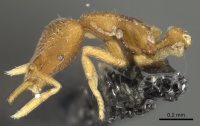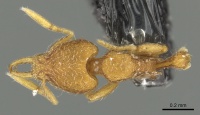Strumigenys yaleopleura
| Strumigenys yaleopleura | |
|---|---|

| |
| Scientific classification | |
| Kingdom: | Animalia |
| Phylum: | Arthropoda |
| Class: | Insecta |
| Order: | Hymenoptera |
| Family: | Formicidae |
| Subfamily: | Myrmicinae |
| Tribe: | Attini |
| Genus: | Strumigenys |
| Species: | S. yaleopleura |
| Binomial name | |
| Strumigenys yaleopleura Brown, 1988 | |
Specimens have been collected from rainforest, most from litter samples. One is noted as collected from under a stone.
Identification
Bolton (2000) - A member of the Strumigenys yaleopleura-group. The mandibles and scapes of yaleopleura tend to average slightly longer (MI 33-35, SI 63-69) than in the other two Malesian species of the group (MI 30-33, SI 55-61), and the mandibles of yaleopleura are broader basally, less strongly bowed outwards and more strongly tapered from base to apex than in either Strumigenys dantalion or Strumigenys furfara. The distribution of flagellate hairs on the middle and hind legs of yaleopleura, with 2 on each tibia and 2 on each basitarsus, is unique in Malesian species of the group, but care should be taken with this character as these hairs are easily abraded. The lamella of the propodeal declivity is very narrow and insignificant in both dantalion and furfara, broad and distinct in yaleopleura. Apart from this dantalion has only a single flagellate hair on the dorsolateral margin of the head, the apicoscrobal, and its pronotum has flagellate hairs only at the humeri. Both furfara and dantalion lack flagellate hairs on the dorsal (outer) surfaces of the middle and hind tibiae. For differentiation of yaleopleura from the Australian endemic species of this group see under the Austral fauna.
Keys including this Species
Distribution
Latitudinal Distribution Pattern
Latitudinal Range: -3.089444444° to -17.68°.
| North Temperate |
North Subtropical |
Tropical | South Subtropical |
South Temperate |
- Source: AntMaps
Distribution based on Regional Taxon Lists
Australasian Region: Australia (type locality).
Indo-Australian Region: New Guinea, Solomon Islands.
Distribution based on AntMaps
Distribution based on AntWeb specimens
Check data from AntWeb
Countries Occupied
| Number of countries occupied by this species based on AntWiki Regional Taxon Lists. In general, fewer countries occupied indicates a narrower range, while more countries indicates a more widespread species. |

|
Estimated Abundance
| Relative abundance based on number of AntMaps records per species (this species within the purple bar). Fewer records (to the left) indicates a less abundant/encountered species while more records (to the right) indicates more abundant/encountered species. |

|
Biology
Castes
Nomenclature
The following information is derived from Barry Bolton's Online Catalogue of the Ants of the World.
- yaleopleura. Strumigenys yaleopleura Brown, 1988e: 41 (w.q.) AUSTRALIA. See also: Bolton, 2000: 914.
Unless otherwise noted the text for the remainder of this section is reported from the publication that includes the original description.
Description
Worker
Bolton (2000) - TL 1.7-1.9, HL 0.42-0.49, HW 0.32-0.38, CI 73-78, ML 0.14-0.18, MI 33-39, SL 0.21-0.24, SI 63-69, PW 0.20-0.22, AL 0.45-0.50 (27 measured).
Dorsolateral margin of head with a freely laterally projecting flagellate hair at level of eye and another in apicoscrobal position; a third is present posterior to this on dorsolateral margin of occipital lobe but this hair may be directed more vertically than laterally. Pronotal dorsum with a pair of flagellate hairs in addition to humeral pair. Pleurae and side of propodeum smooth. Basitarsus of hind leg with 2 long fine erect flagellate hairs on its dorsal (outer) surface and two similar hairs on dorsal (outer) surface of hind tibia; this pilosity also present on middle leg. Propodeal declivity with a distinct lamella, the lamella subtending two-thirds or more of length of tooth and its posterior (free) margin straight to extremely feebly concave. Disc of postpetiole smooth but some samples with a few very short longitudinal costulae immediately behind its anterior border.
Type Material
Bolton (2000) - Holotype worker, AUSTRALIA: Queensland, Atherton Tableland, Malanda, 800 m., 5.xi.1950, in rotten root (W. L. Brown); paratype workers and queens, AUSTRALIA: Queensland, Kuranda, 350 m., 30.x.1950 (W. L. Brown); Qld, 10 miles from Atherton on Herberton Rd, 13.vi.1962, no. 1561 (R. W. Taylor); Iron Range, 14.vi.1971, ANIC 312 (Taylor & Feehan); Rocky River, NE of Coen, 1.vi.1958 (P. F. & P. J. Darlington) (Museum of Comparative Zoology, Australian National Insect Collection, The Natural History Museum) [examined].
- Holotype, worker, Malanda, Queensland, Australia, Museum of Comparative Zoology.
- Paratype, worker(s), queen(s), Kuranda, 10mi. from Atherton on Herberton Road, Iron range or Rocky River, Queensland, Australia, Australian National Insect Collection.
- Paratype, worker(s), queen(s), Kuranda, 10mi. from Atherton on Herberton Road, Iron range or Rocky River, Queensland, Australia, The Natural History Museum.
References
- Bolton, B. 2000. The ant tribe Dacetini. Memoirs of the American Entomological Institute. 65:1-1028. (page 914, fig. 539 redescription of worker)
- Brown, W. L., Jr. 1988e. Strumigenys yaleopleura species nov. Pilot Regist. Zool. Card No. 41.
- Shattuck, S. O. 1999. Australian ants. Their biology and identification. Collingwood, Victoria: CSIRO Publishing, xi + 226 pp. (page 168, see also)
References based on Global Ant Biodiversity Informatics
- Andersen A. N., M. Houadria, M. Berman, and M. van der Geest. Rainforest ants of the Tiwi Islands: a remarkable centr of endemism in Australia's monsoonal tropics. Insectes Sociaux 59: 433-441.
- Bolton, B. 2000. The Ant Tribe Dacetini. Memoirs of the American Entomological Institute 65
- Brown W. L., Jr. 1988. Strumigenys yaleopleura species nov. Pilot Regist. Zool. Card No. 41.
- CSIRO Collection
- Janda M., G. D. Alpert, M. L. Borowiec, E. P. Economo, P. Klimes, E. Sarnat, and S. O. Shattuck. 2011. Cheklist of ants described and recorded from New Guinea and associated islands. Available on http://www.newguineants.org/. Accessed on 24th Feb. 2011.
- Snelling R. R. 2000. Ants of the Wapoga river area, Irian Jaya, Indonesia. In Mack, Andrew L. and Leeanne E. Alonso (eds.). 2000. A Biological Assessment of the Wapoga River Area of Northwestern Irian Jaya, Indonesia. RAP Bulletin of Biological Assessment 14, Conservation International, Washington, DC.

